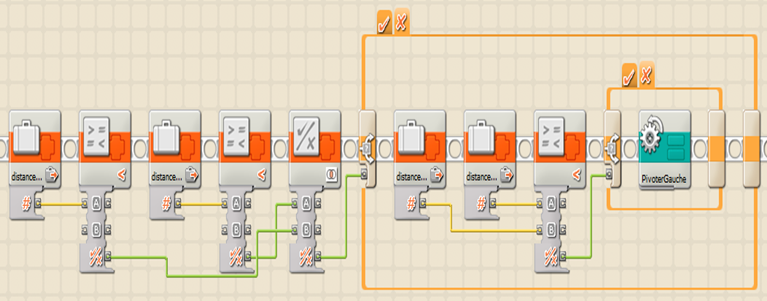Contents
ToggleCorrected exercises on the Lego Mindstorms robotics software
This series of corrected exercises on Lego Mindstorms allows you to become familiar with programming and robotics software.

Exercise 1
In this exercise, you will learn how to program the robot to perform simple movements. Understanding how to make your robot perform its movements is essential because it will constantly need to perform them in the following exercises.
Using the programming guide provided to you, please program your robot
so that it performs the following actions:
move forward for a period of 3 seconds,
go back for a period of 3 seconds,
turn to the left then to the right.
This exercise aims to simply explain how to program the robot using LEGO software. There are two ways to approach these problems:
either by using the Move block (which allows you to control both motors at once), or by using two Motor blocks (one for each motor, which allows you to control each motor independently).
The second way uses loops so it is best to approach it if students are comfortable with this notion (which will be seen in the second exercise).
– move forward for a duration of 3 seconds, Place a Move block, check motors B and C and enter 3 seconds as the duration.
– go backwards for a duration of 3 seconds, Same as for the previous exercise except that you must select the “Backward” direction.
– turn on angles to the left then to the right. Place the “Direct” cursor either all the way to the right or all the way to the left.
Exercise 2
and in programming, a loop is a control structure that allows a series of instructions to be repeated as long as a condition is true or is not met (depending on the type of loop used). There are several types such as for example While (condition) do. A loop can also be infinite, that is to say that its instruction block will be repeated indefinitely (more concretely: until stopped manual from the program).
The robot is equipped with a number of sensors (a more precise description of each is given in the guide provided). These sensors make it possible to measure different parameters of the environment in which the robot operates. It is possible to use these measurements as a condition for stopping the loops and this is what will interest us later.
An infinite loop therefore allows us to have the robot perform an action (or a sequence of actions) without any particular stopping condition.
- Make your robot perform an unlimited circle-shaped trajectory
- Move forward and backward (only a short distance) unlimitedly
- Loop with stop condition
A loop is most generally used with a stopping condition, that is to say that all of the instructions in the loop body will only be executed as long as the specified condition is true (from a point of logical view). In pseudo-code, a loop is written as follows:
As long as (condition) TO DO
instructions
End While
You will then be asked to think about the algorithms of your programs and write them in the form of pseudo-code. The pseudocode is a language close to natural, that is, when writing the algorithm you do not need to think about the implementation (how to translate it into the programming language).
In the case of our robot, we can put logical operations, a counter or sensors as conditions and this is what we will see here. For example, let's admit that our robot has a noise detection sensor (this is not the case in reality) and that we want it to move forward until it detects a noise, a pseudo-algorithm. code would be: algorithm in pseudo-code would be:
As long as (undetected noise)
Move forward()
End While
When it detects the noise, it will stop repeating its block of instructions.
For each of the following actions and using a separate sensor, write a small algorithm in pseudo-code then program it:
- Move the robot forward then stop 20 cm from an obstacle,
- Make the robot move forward then stop when it comes into contact with an obstacle,
- Make the robot move forward then stop when it sees a color on the ground.
Infinite loop
- Make your robot perform an unlimited circle-shaped trajectory
To do this, you must use two blocks Engines and place them in an “unlimited” loop. To make the trajectory in a circle, one motor must rotate faster than the other (play on the “Power” parameter) such as B at 75 and C at 40.
- Move forward and backward (only a short distance) unlimitedly
You must put two motor units to move forward (same power, same direction, same duration) in an infinite loop, then put two motor units back to move backward (the direction must be reversed in relation to the action of moving forward).
Please note, for the two motors to be active in parallel, the duration must be in degrees (for example 500) or rotations and the first of the two motor blocks (for each action), must have the “Wait for end” option unchecked.

Loops with stopping conditions
- Move the robot forward then stop 5 cm from an obstacle,
While (distance() ≥ 5)
move forward()
End While
The loops used by the LEGO programming software are not While, that is, the condition of the loop is the condition of exit loop and not the validity condition.
Here, the loop must therefore have the ultrasonic sensor as a “Control” parameter and as a “Until” condition. < 5 cm”. This loop must contain two blocks Engines for motors B and C with the same power and the same direction and whose duration is “unlimited”.

- Make the robot move forward then stop when it comes into contact with an obstacle,
While (TouchSensor not pressed) do
Move forward()
End While
The loop must contain two blocks Engines for motors B and C (same power, same direction, unlimited duration) and have one of the touch sensors as control with the condition “Action: pressed”.

Please note: this version is simple but the robot only stops when it comes into contact with a single sensor. It is nevertheless possible to use a logical equation to bring the two sensors into play (the robot stops with the contact of one of the two sensors). To do this, you must use two “Touch Sensor” blocks and construct the following logic equation (which you enter as a condition in a loop with “Logic” as a control):
E = 1 + 2

- Make the robot move forward then stop when it sees a color on the ground.
The color chosen doesn't really matter, but black is a practical choice because it can be measured with the color or brightness sensor.
While (color() /= black) do
Move forward()
End While
The loop must contain two blocks Engines for motors B and C (same power, same direction, unlimited duration) and have as control the color sensor in “Color” mode with the condition “Up to the range” and the cursors framing black.

The color sensor can be used in “Photosensitive” mode for this exercise if the stopping color is black. To do this, in the “Photosensitive” mode set the condition “Until < X" Or X is an upper limit of black to be determined by measurement on the support used as a test track.
Exercise 3
You will have to program your robot so that it counts the colors. He must be able to advance along an area comprising a succession of colored areas, although the end of this area is marked by a black band. He must therefore count the number of times a colored strip appears while moving his screen forward. At the end of the course, it will display the number of color zones on the screen.
- Write an algorithm corresponding to this problem in pseudo-code
- Implement your algorithm in your robot
The goal of this exercise is to reuse what has been seen so far (loops, sensor) while introducing the notion of variable (from an algorithmic point of view and at the level of the robot programming software).
- Write an algorithm corresponding to this problem in pseudo-code
ColorPrevious ← color() NbRed ← 0
NbYellow ← 0
NbBlue ← 0
While (ReadColor() =/ BLACK) do
While (color() = PreviousColor)
Move forward()
End While
If (color() = RED) then NbRed = NbRed + 1
If (color() = YELLOW) then NbYellow = NbYellow + 1
If (color() = BLUE) then NbBlue = NbBlue + 1
End if
ColorPrevious ← color()
End While
color() is a function that returns the numerical value of the color read by the color sensor.
This algorithm works as follows: the robot advances as long as it is still in the same color zone then as soon as it has changed zone, it then increments the variable associated with this color. It ends up updating the PreviousColor variable to detect the change of zone on the next loop. The whole thing is in a black detection loop which will stop the robot as soon as it reads black.
- Implement your algorithm in your robot
To program it, we must first create the variables that will be used later (Previous Color, Red, Blue, Yellow); they are of digital type and initialized from the start of the program.
Then we place a main loop with the control “Color sensor” and the action “Up to the black range”. Within this loop we put back a loop containing two motor blocks to move the robot forward (duration set to “Unlimited”). The control of this loop must be placed on “Logic” with as input a comparison operation between the “Previous Color” variable and the color sensor:

After this loop, we place three switch blocks (one for each color) in which we execute the operation of incrementing the associated color variable. Here for example is the red one:

Then, after these three switches, we do not forget to update the “Previous Color” variable with the color sensor (as during initialization).
After the loop main, we display the content of the color variables on the screen or with sounds.
Exercise 4
The robot must follow a black path on the ground, the ground being white.
- Write an algorithm corresponding to this problem in pseudo-code
- Implement your algorithm in your robot.
Bonus question: can your program follow all types of routes?
- Write in pseudo-code an algorithm corresponding to this problem
As long as (true) do
While (color() = BLACK) do
ShiftLeft()
End While
While (color() = WHITE) do
DeviateRight()
End While
End While
color() is a function that returns the numerical value of the color read by the color sensor.
DeviateLeft() and DeviateRight() are functions that move the robot forward by deviating to the left or to the right.
A line follower actually follows not the line but the edge of the line (the boundary between white and black). The algorithm presented here is very simple. Within an infinite loop, we place two loops: one for black and one for white. The black loop deviates the robot to the left as long as it reads black, and the white loop deviates the robot to the right as long as it reads white. Thus, the robot alternates movements to the left and to the right.
Note: this algorithm corresponds to a “left follower”, that is to say in the case where white is to the left of black. We can make a “right follower” by reversing the direction of deviation.
- Implement your algorithm in your robot
To implement it in the robot, we first place a “loop” block with “Forever” as a control.
In this block, we then place another loop but this time with the control “Color sensor” in “Photosensitive” mode and with the action “Until < 35” (35 is a value of the upper limit of black brightness, this value must be determined by measurement during the session because it can vary depending on the lighting or the test track used).
Inside this loop, place two “Motor” blocks for each of the two motors, one of which has a lower power than the other (to deviate to the left, motor C must go slower than B ). Make a similar loop for the white with this time action positioned on “Until > 35” and the motor powers reversed.
The difference between the respective powers of the motors will affect both the overall speed of the robot (the time it will take to make a complete turn) and its ability to follow a path more or less twisted. To do this, do not hesitate to do several tests with different values to find a good compromise (correct values are for example 75 and 10).

Bonus question: can your program follow all types of routes?
Normally this program does not allow you to follow all types of tracks. Indeed, as soon as the route becomes too complex, the robot should no longer be able to follow (unless one of the two motors is almost stopped, which will then make it very slow). It cannot follow an inside or too tight turn, nor a right angle turn. To be convinced, don't hesitate to perform it on the bonus circuits.
Exercise 5
When carrying out certain tasks, your robot often has to repeat standard actions several times, such as turning 90° to the right or moving forward 10 cm. For'alleviate your program, it is possible to create personalized blocks which are subsequently used like the default blocks (in this way, instead of having several times the different blocks which manage the angle calculations and the activation of the motors, we only use one several times). This principle is similar to functions (or procedures) in algorithmics.
As a reminder, in algorithmics, a function is a sequence of instructions relatively independent of the main program and which is repeated several times. This sequence of instructions is then grouped into a single instruction block which is the function.
Using the programming guide (and more particularly the block creation section) as well as the appendix on distance and rotation calculations, create the following personalized blocks:
- Move forward: moves the robot forward according to the distance given as input (this distance will be in centimeters),
- Back up: moves the robot back according to the distance given in input (this distance will be in centimeters),
- TurnRight: turns the robot at a given input angle to the right,
- TurnLeft: turns the robot at a given input angle to the left,
- RotateRight: rotates the robot at a given input angle to the right,
- RotateLeft: rotates the robot at a given input angle to the left
Now, using the blocks you just created, please create a program that allows your robot to perform this trajectory:

You must therefore use the programming guide as well as the appendix on distances and rotations to create the blocks and implement the formulas using the operation blocks.
– Move forward: moves the robot forward according to the distance given as input (this distance will be in centimeters),
It is therefore necessary to code the formula distance*360/13.5 using constants for 360 and 13.5 and a variable in reading mode for the distance; then give the result as the input value of a block Move set to a duration in “Degrees”. To create the block, simply select all these blocks except the variable block for the distance, then go to To modify → Create new block My block :
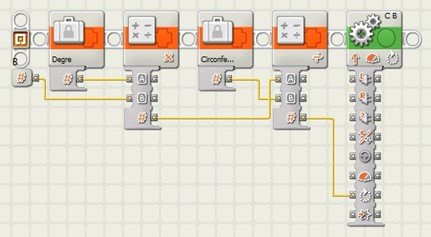
- Back up: moves the robot back according to the distance given in input (this distance will be in centimeters),
You must code the same formula as for the block Move forward but this time the block Move must be set to rotate the motors in the other direction.
- TurnRight: turns the robot at a given input angle to the right,
This time, it's the formula angle*2pi*15.5/13.5 and put the result at the input of motor C (motor B must be deactivated).

- TurnLeft: turns the robot at a given input angle to the left,
The formula remains the same as before but this time it is motor B which is activated and motor C which is deactivated.
- RotateRight: rotates the robot at a given input angle to the right,
The formula is almost the same as before except that we remove the coefficient 2 (the circle described being half as large). Furthermore, the result of the calculation is given as input to engines B and C this time; the C motor going forward and the B motor going backwards.
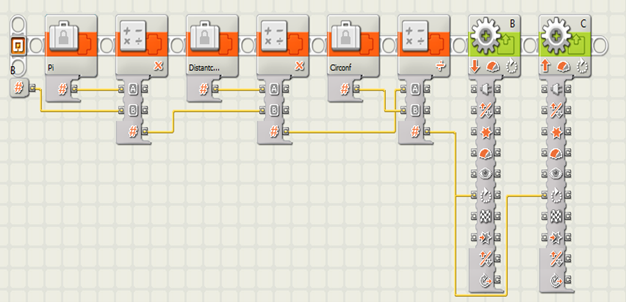
- RotateLeft: rotates the robot at a given input angle to the left. Same formula as for the previous block except that the directions of the motors are reversed
The files are to be placed in the Blocks/My blocks folder of the profile folder: Forward.rbt, Backward.rbt, RotateLeft.rbt, RotateRight.rbt, PivoterLeft.rbt, PivoterDroite.rbt
The trajectory to then be made by the robot is rather simple with the blocks. It is therefore necessary to place the blocks successively Move forward, RotateRight, Move forward, RotateLeft, Move forward, RotateRight, Move forward, SwingRIGHT, Move forward, RotateRight with associated distances and angles. Be careful, however, to take the correct angle value for the pivots (you must take the value of the additional angle).

Exercise 6
Using a state graph (finite state automaton), give the program the following actions.
- Stop at the right place
The initial state considers the robot in white, this allows you to start the robot from anywhere (i.e. white or black). Each time it changes color (black or white), it will move to the next state. Each state has the associated action of moving forward except the state following the third transition black (which therefore corresponds to the third time that the robot encounters a black zone) where the robot stops.

2. Obstacle detection, the robot moves straight forward then reverses if it hits an obstacle
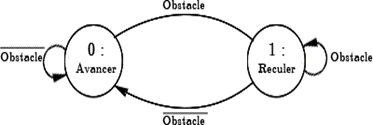
3. The robot goes straight ahead then turns right (resp. left) if it encounters an obstacle on the left (resp. right) or turns around if the obstacle is in front of it.

1.
To program this state graph, you must first create a numeric type variable state which will contain the current state. It will be initialized to 0 at the start of the program. We add within a loop so the condition is until state = 5, a first switch on the value of the variable state which will allow the value of the current state to be changed according to the actions detected (reading white or black) followed by a second switch also on the value of the variable state which will determine the actions to be performed in each state:

2.
You must proceed in the same way as for the previous program: two switches; one for transitions and one for actions. However, in the file provided as a correction we grouped these two switches into one to show that this was also possible. Changing the variable state is therefore done at the end of the action loop. This way is more compact but a little less clear and organized but remains possible and functional.
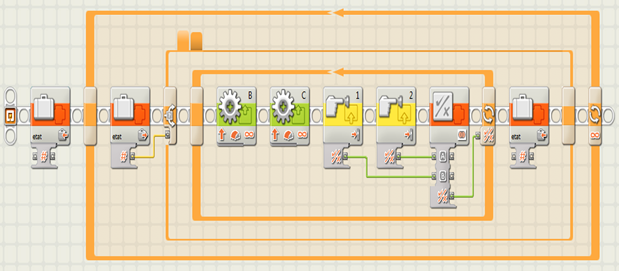
3.
We therefore use the same program structure as before but this time clearly differentiating the contact on the left or on the right.
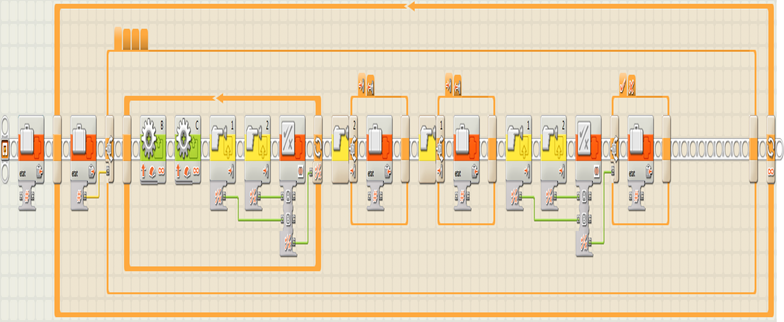
Exercise 7
We will try to program the robot so that it searches for an object in a space delimited by a black line and takes it out of this space. Your program must therefore include two distinct phases: a first of searching for the object and a second of removing the object from this space (it will remove the object by pushing it outwards).
Your program must be clever : you do not have to program the robot so that it goes directly to the object (the latter can be located anywhere in space). In addition, the robot will have to start in a very distinct position. Here is an example of object placement:
- Describe a simple algorithm to perform this task,
- Create a program that performs these actions based on the algorithm.

1.
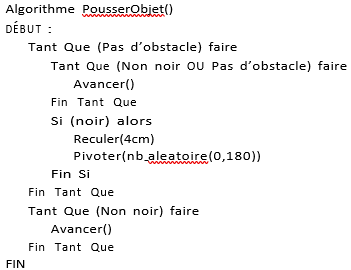
First, the robot advances until it either encounters darkness or touches an object. If it encounters black, it backs up and then rotates at a random angle (between 0 and 180 degrees) then leaves again. If it comes into contact with an object, it then continues to advance until it encounters black; he will then have taken the object out of the frame.
2.
To program this, we start by placing a loop with the logical condition that one of the tactile sensors is pressed (so use the blocks for these sensors with a logic block OR ). We then place inside this loop a loop with the logical condition Black OR (Touch1 OR Touch2), we stop the motors at the exit of this loop so that the robot does not leave the frame if the loop stopped because it saw black:

We then place a switch to see if the loop was interrupted because the robot saw black. In this case, we place a block To move back – created in the previous exercise – followed by a block Random which takes a number between 0 and 180 and gives it as input to a block RotateLeft.
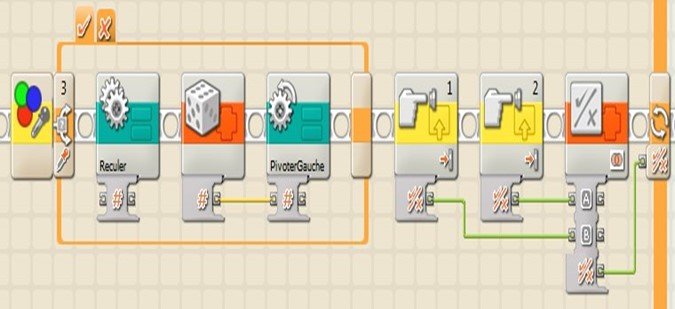
After the main loop, we place a loop making the robot move forward until it sees black.
Exercise 8
As in the previous exercise, we will program our robot so that it searches for an object in a space. Except that in this version we will use the ultrasonic sensor. It is therefore a question of programming the robot so that it first searches in which direction the object is located, then it moves towards it and stops 5 cm away.
- Write an algorithm corresponding to this problem in pseudo-code
- Implement your algorithm in your robot
1.
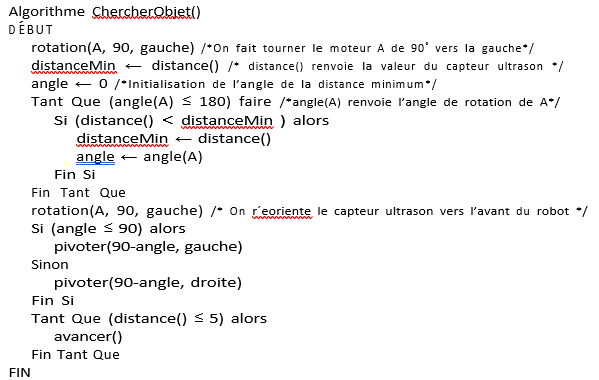
Here, rather than blindly searching for the object, the robot will search in which direction it is located. To do this, the sensor will scan the entire space in front of the robot (the sensor will rotate through an angle of 180˚) and look for the shortest distance to an obstacle (on the same principle as a minimum search algorithm in a painting) ; it will memorize the angle to deduce the direction in which the robot will go.
2.
First, we rotate motor A 90˚ to the left to orient the ultrasonic sensor, then we place a sensor block just after Rotation to reset the value returned by the latter. We then store in a variable distanceMin the value returned by the ultrasound sensor and we initialize another variable corner to 0. And finally, we start a slow rotation of A towards the right:

We now place a loop in which we will carry out the comparisons to find the angle of the minimum distance. This loop controls the rotation sensor of motor A and as a condition until > 180˚. At the start of the loop, we store in Number 1 the distance measured by the ultrasonic sensor and in corner the value returned by the rotation sensor of A. Comparisons and possible assignments are then made with these variables.
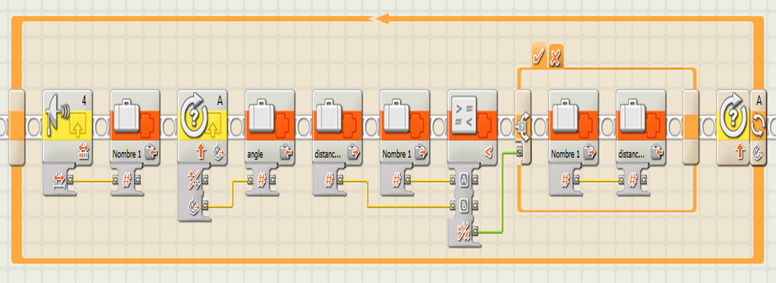
Finally, after the loop, motor A is stopped and then rotated 90˚towards the left to refocus the ultrasonic sensor. We then rotate the robot according to the value of corner then we advance it up to 5 cm from the object:
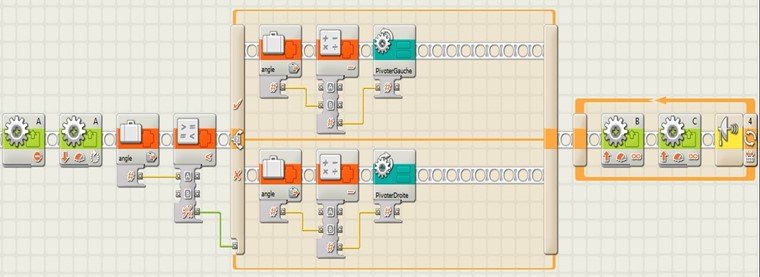
ANOTHER APPROACH:
We slowly rotate the ultrasonic sensor until there is an obstacle and at this moment we make the robot move towards it. This approach therefore assumes that the space in front of the robot (therefore over a given distance, for example 40 cm) only contains the desired object, it therefore remains less good than the previous one but simpler to understand, which is why it is presented here:
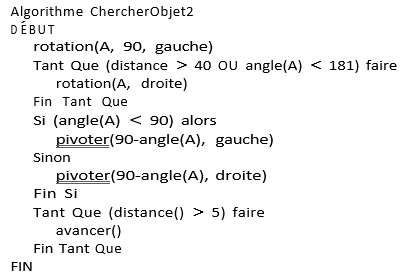
The program therefore closely resembles the initial version, except that the rotation of motor A stops as soon as it detects an object.
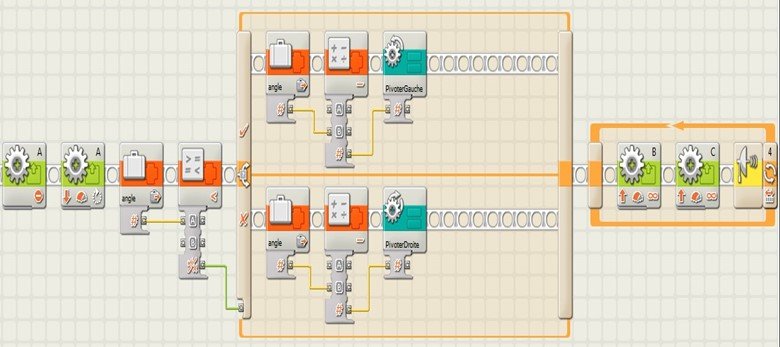
Exercise 9
We will now program the robot so that it is able to escape from a maze simple. Be careful, finding a path to cross a maze is a difficult problem from a computer point of view (we speak of a problem NP-Complete ), this is why all the proposed mazes are simple because you are not asked for an efficient algorithm for all the mazes.
A- Basic maze
The first type of maze is made up only of high walls (25 cm). Here is his plan:

You will therefore have to program your robot so that it crosses it. To do this, you will need to use the ultrasonic sensor to determine which way to go at each intersection.
- Write in pseudo-code a naive algorithm allowing the robot to traverse such a maze
- Implement your algorithm in your robot
B- Advanced maze
We now modify the maze by replacing a high wall with a low obstacle (10 cm).
How can I make the robot always go through the maze?
- Modify the previous algorithm to take this change into account
- Implement your modified algorithm into your robot
C- Impasse
We will now take this labyrinth layout:

As you can see, this maze has a dead end. What to do if your robot ends up in it?
- Modify the previous algorithm to take into account deadlocks
- Implement your modified algorithm into your robot
- Bonus question: can he get through all the mazes?
HAS-
This first type of maze only has one path that leads directly to the exit. The goal is to understand the behavior of the robot within this maze; that is to say, advance up to a wall then look for which way to turn.
To know which way to turn, you can have several approaches, such as looking arbitrarily to the left to see if there is an obstacle and, if necessary, turning left if not right. In the following algorithm (and therefore the proposed program), at each intersection the robot turns to the side where the obstacle is furthest away. Here is the algorithm:
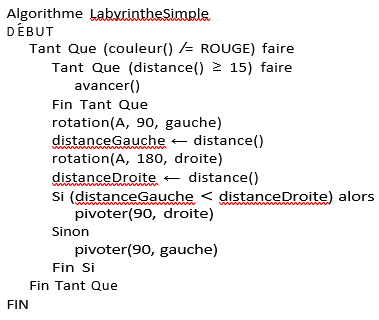
The robot advances up to 15 cm from the wall then stops. He then measures the distance separating him from the wall on the left then from the wall on the right. it then turns to the side where this distance is greatest and then begins to move forward again. He stops as soon as he sees red.
We start by placing blocks Variable in fashion To write to initialize variables distanceLeft and distanceRight to 0. Then, we place a loop with the color sensor as control and the stopping condition All the way to the red beach (this loop will end the program when the robot is at the end of the maze).
We then place a loop to move the robot forward to an obstacle. It must therefore contain two blocks Engine for B and C with a as duration Unlimited.
. Be careful, the robot must stop (and therefore exit this loop) either 15 cm from an obstacle, or when it sees red; the control must therefore not be the ultrasonic sensor but a logical equation constructed with two sensor blocks (ultrasonic sensor set to distance less than 15 cm and color sensor set to in the red beach) :
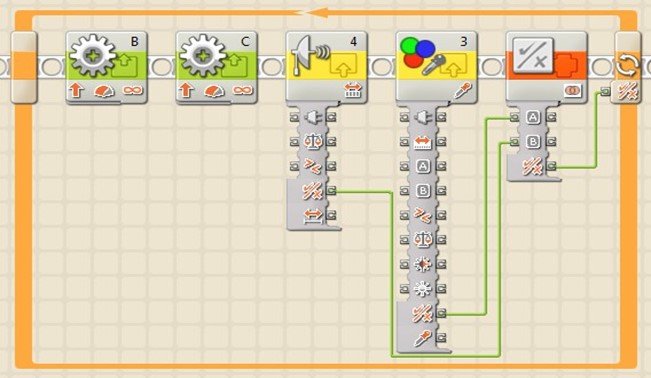
The rest of the program is the set of instructions corresponding to choosing which way the robot will turn. This part takes place within a switch with the color sensor as control and set to Out of the red beach ; in fact, this allows you not to search for obstacles if the robot has stopped.
The first step therefore consists of rotating the motor A to the left then recording the value returned by the ultrasonic sensor in distanceLeft, then turn motor A to the right and record the value returned by the ultrasonic sensor in distanceRight. We then compare the two variables and in a switch logic which takes as input the result of the comparison, we use the blocks RotateRight Where RotateLeft created in a previous exercise (with 90 as input angle value) to turn to the correct side:

B-
We now modify the maze by replacing a high wall with a low obstacle (10 cm).
To take this change into account, the use of the touch sensor must be added. We will therefore make the robot stop if it hits an obstacle that it could not have seen with the ultrasonic sensor.
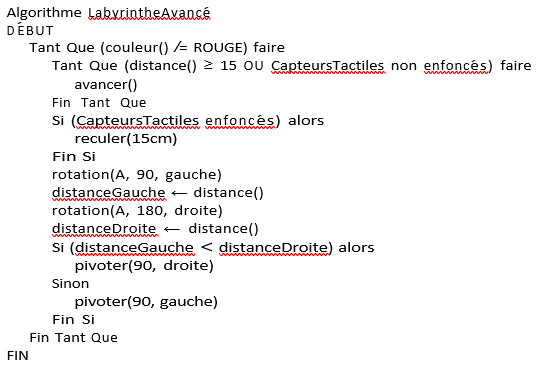
The algorithm is almost the same as for the previous question. Only the condition of the loop to move the robot forward has changed: the robot stops moving forward if it is 15 cm from an obstacle OR if it touches an obstacle. After this loop, we add a condition to check if it is the second case (tactile sensors) which made the robot stop, and if this is the case, we make it move back 15 cm. The rest of the algorithm is unchanged.
So all you have to do is take the previous program and make a few modifications and additions. It is necessary to modify thelogical equation loop control that moves the robot towards an obstacle. The robot must now stop if it is 15 cm from an obstacle or if it sees red or if it comes into contact with an obstacle. We must therefore add the blocks corresponding to touch sensors 1 and 2 with a logic block (type OR ) :
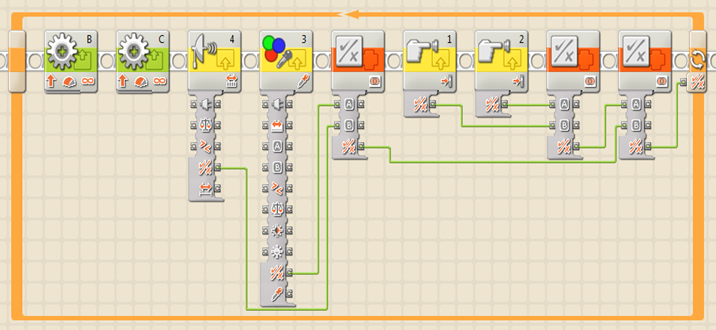
After this loop, we place a switch to check if we have left the loop because of the tactile sensors and move the robot back 15 cm if necessary (for this, we can use the block created to move back):
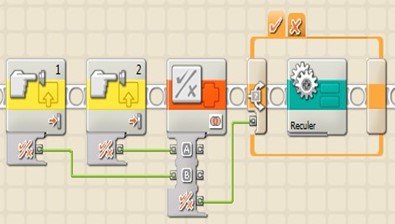
VS-
The robot is in an impasse if, when it is stopped (therefore blocked by a wall facing it), the walls on the left and right are too close to it (the distance measured on the left is less than a certain distance – here we chose 20 cm –, the same for the distance measured on the right). We must therefore modify the condition to decide which side to turn:

The algorithm is therefore very similar to the previous one. We added the condition If (distanceLeft < 20 AND distanceRight < 20) which makes it possible to detect a dead end and therefore makes the robot turn around if this is the case. Otherwise the decision on which side to turn remains the same.
To detect dead ends, we take the advanced maze program and place the blocks used to determine which way the robot will turn in a switch having a logical value as control: the value will be the result of the equation distanceLeft < 20 AND distanceRight <20 :
